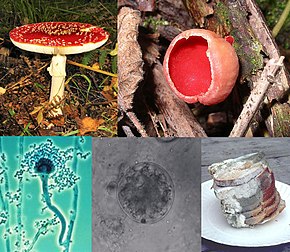
Back Swam Afrikaans Pilze ALS ፈንገስ Amharic Fungi AN फफूंदी ANP فطر Arabic فطر ARZ ভেঁকুৰ Assamese Fungi AST Ocockweto ATJ
| Fungi | |
|---|---|

| |
Clockwise from top left:
| |
| Scientific classification | |
| Domain: | Eukaryota |
| Clade: | Obazoa |
| (unranked): | Opisthokonta |
| Clade: | Holomycota |
| Kingdom: | Fungi |
| Subkingdoms/Phyla/Subphyla | |
|
Dikarya (inc. Deuteromycota) Subphyla incertae sedis | |
A fungus (plural: fungi) is a type of living organism that includes yeasts, molds, mushrooms and others. Fungi are a category of organism as large and varied as the animals or plants. Fungi, animals and plants are each Kingdoms of life.[1][2]
Historically people thought fungi were most like plants, even calling fungi a type of plant. However fungi are not plants. Fungi are even more closely related to animals than to plants.
The study of fungi is known as mycology from "myco-" meaning fungi and "-ology" meaning "study of".
- ↑ Jennings D.H. & Lysek G. 1996. Fungal biology: understanding the fungal lifestyle. Guildford, UK: Bios Scientific Publishers . ISBN 978-1-85996-150-6
- ↑ Kirk P.M. et al 2008. Dictionary of the fungi, 10th ed. Wallingford, UK: CAB. ISBN 0-85199-826-7